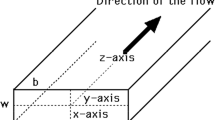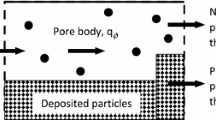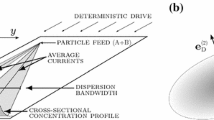Summary
The particle-wall interactions in field-flow fractionating channels are described phenomenologically using the distribution coefficient, k. The time dependencies of the first and second dispersion coefficients are calculated and compared with the known solutions for the case of no adsorption. The results for the retention ratio and peak broadening are compared with the known experimental work. The model predicts the increase of peak broadening with the growth of particle-wall interactions that is consistent with the experimental data. The dependence of peak asymmetry on transverse Pe number and distribution coefficient is studied.
Similar content being viewed by others
References
J. C. Giddings, F. J. Yang, M. N. Myers, J. Virology,21, 131 (1977).
M. E. Hansen, J. C. Giddings, Anal. Chem.,61, 811 (1989).
V. P. Andreev, L. A. Stefanovich, Nauchnoye, Priborostroenie,1, 53 (1991) (in Russ.).
S. Krishnamurthy, R. S. Subramanian, Separation Science,12, 347 (1977).
Author information
Authors and Affiliations
Rights and permissions
About this article
Cite this article
Andreev, V.P., Stefanovich, L.A. Theory of field-flow fractionation with the reversible adsorption on channel walls. Chromatographia 37, 325–328 (1993). https://doi.org/10.1007/BF02278642
Received:
Revised:
Accepted:
Issue Date:
DOI: https://doi.org/10.1007/BF02278642




